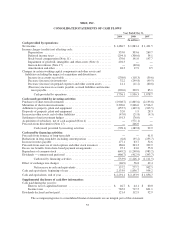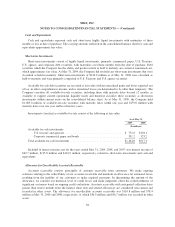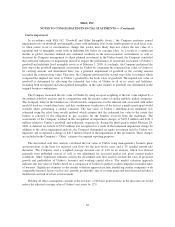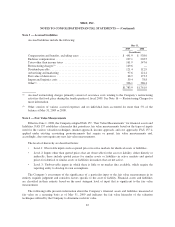Nike 2009 Annual Report Download - page 63
Download and view the complete annual report
Please find page 63 of the 2009 Nike annual report below. You can navigate through the pages in the report by either clicking on the pages listed below, or by using the keyword search tool below to find specific information within the annual report.NIKE, INC.
NOTES TO CONSOLIDATED FINANCIAL STATEMENTS — (Continued)
The Company adopted the modified prospective transition method prescribed by FAS 123R, which does not
require the restatement of financial results for previous periods. In accordance with this transition method, the
Company’s consolidated statements of income for the years ended May 31, 2009, 2008 and 2007 includes
(i) amortization of outstanding stock-based compensation granted prior to, but not vested, as of June 1, 2006,
based on the fair value estimated in accordance with the original provisions of SFAS No. 123, “Accounting for
Stock-Based Compensation” (“FAS 123”) and (ii) amortization of all stock-based awards granted subsequent to
June 1, 2006, based on the fair value estimated in accordance with the provisions of FAS 123R.
To calculate the excess tax benefits available for use in offsetting future tax shortfalls as of the date of
implementation, the Company is following the alternative transition method discussed in FASB Staff Position
No. 123R-3, “Transition Election Relating to Accounting for the Tax Effects of Share-Based Payment Awards.”
See Note 11 — Common Stock and Stock-Based Compensation for more information on the Company’s
stock programs.
Income Taxes
The Company accounts for income taxes using the asset and liability method. This approach requires the
recognition of deferred tax assets and liabilities for the expected future tax consequences of temporary
differences between the carrying amounts and the tax basis of assets and liabilities. United States income taxes
are provided currently on financial statement earnings of non-U.S. subsidiaries that are expected to be
repatriated. The Company determines annually the amount of undistributed non-U.S. earnings to invest
indefinitely in its non-U.S. operations. The Company recognizes interest and penalties related to income tax
matters in income tax expense. See Note 9 — Income Taxes for further discussion.
Earnings Per Share
Basic earnings per common share is calculated by dividing net income by the weighted average number of
common shares outstanding during the year. Diluted earnings per common share is calculated by adjusting
weighted average outstanding shares, assuming conversion of all potentially dilutive stock options and awards.
See Note 12 — Earnings Per Share for further discussion.
Management Estimates
The preparation of financial statements in conformity with generally accepted accounting principles requires
management to make estimates, including estimates relating to assumptions that affect the reported amounts of
assets and liabilities and disclosure of contingent assets and liabilities at the date of financial statements and the
reported amounts of revenues and expenses during the reporting period. Actual results could differ from these
estimates.
Reclassifications
Certain prior year amounts have been reclassified to conform to fiscal year 2009 presentation, including a
reclassification to investing activities for the settlement of net investment hedges in the consolidated statement of
cash flows. These reclassifications had no impact on previously reported results of operations or shareholders’
equity and do not affect previously reported cash flows from operations, financing activities or net change in cash
and equivalents.
61
























